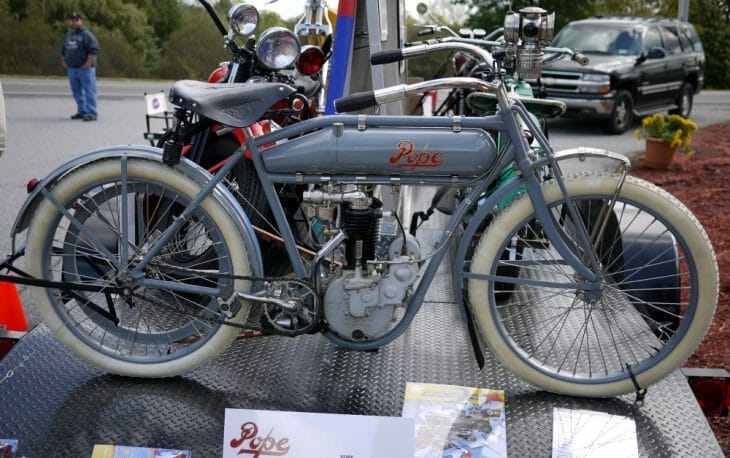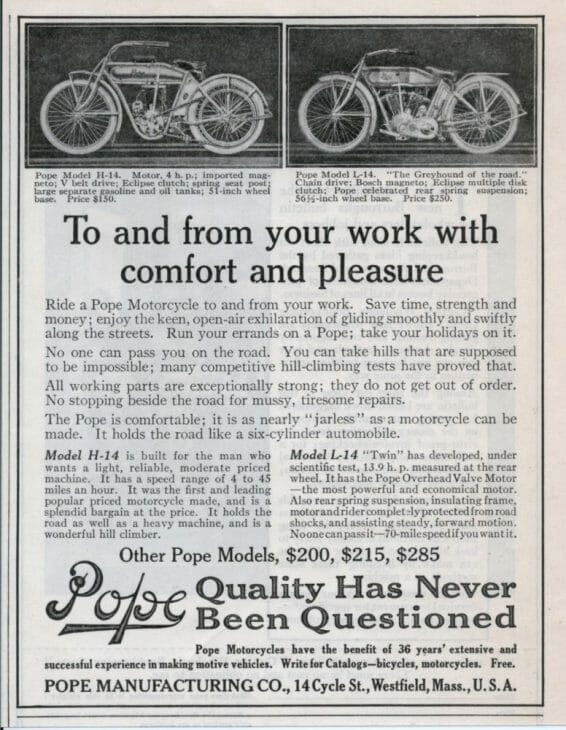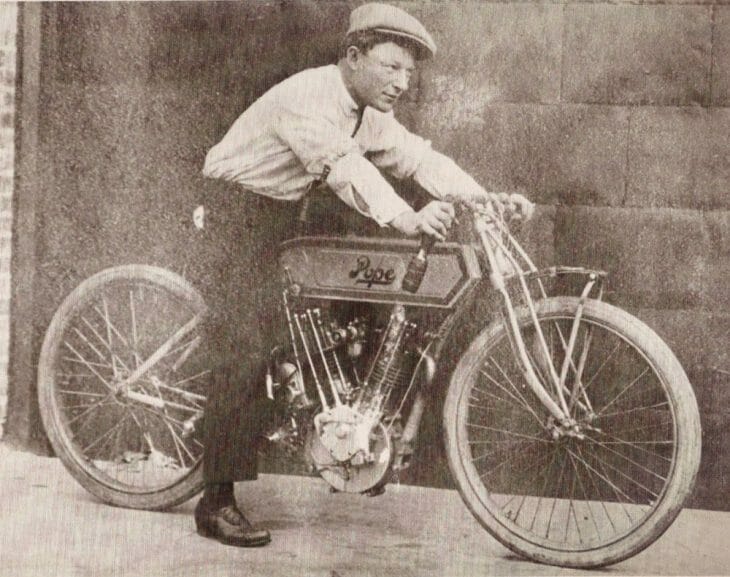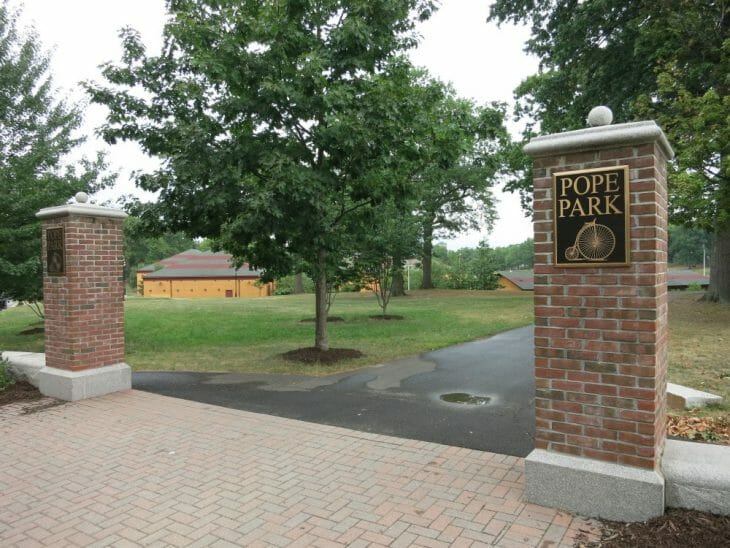Larry Lawrence | September 21, 2016

On a recent vacation to New England, I happened to be in Hartford, Connecticut, and in reading about local attractions I noticed an entry about Pope Park. I read about the park and discovered the land was donated to the city by Colonel Albert Pope, who was the head of the Pope Manufacturing Company. I knew about Pope motorcycles, one of the most collectable marques of the early American makers, and sure enough the same Pope who donated the park was also the motorcycle maker. Pope became one of the most technologically advanced motorcycles of the 1910s and developed overhead valves and full suspension well ahead of most other American motorcycle manufacturers.
The origins of Pope can be traced to Boston just after the Civil War. Colonel Pope came back from the war looking to invest the money he’d saved during his service to start a business. Pope formed his business with other family members and the company was according to Boston corporation records “to make, manufacture and sell and license to others to make, manufacture and sell air pistols and guns, darning machines, amateur lathes, cigarette rollers and other patented articles and to own, sell and deal in patents and patent rights for the manufacture.”
Colonel Pope made an amazingly forward-looking decision to buy the patents for the bicycle from its French inventor Pierre Lallement (interestingly Lallement actually came to work for Pope and his bicycle company for a time). Owning the patents to the bicycle when the bicycling craze took over America in the 1890s proved very profitable for Pope. His company also became the leading bicycle maker in America during the late 1890s, with the factory located in Hartford.

Always looking to expand and diversify, with the profits from bicycling, Pope began making battery-powered automobiles in 1897. The electric vehicle division was spun off that year as the independent company Columbia Automobile Company and was acquired by the Electric Vehicle Company by the end of 1898. Pope tried to re-enter the automobile manufacturing market in 1901 by acquiring a number of small firms, but the process was expensive and many other makers were entering the market. Between the years 1903 and 1915, the company operated a number of automobile companies including Pope-Hartford (1903-1914), Pope-Robinson, Pope-Toledo (1903-1909), Pope-Tribune (1904-1907) and Pope-Waverley, but a breakthrough to profitability in auto making never happened for Pope.
Being a bicycle and auto maker naturally led to Pope expanding into the burgeoning motorcycle market. Pope was one of the earliest motorcycle makers in America, at first utilizing clip-on French de Dion-Bouton engines. They were marketed through the company’s vast bicycle dealer network under various names including Monarch, Cleveland, American, Imperial and Columbia. The first Pope motorcycle bearing the Pope name didn’t appear until 1910, a year after Colonel Pope’s passing.

It was under the guidance of Colonel Pope’s son, Albert Linder Pope, when emphasis was really focused on motorcycle manufacturing. Production of the Pope motorcycle was done in a large manufacturing factory in Westfield, Massachusetts. No doubt there was benefit derived by having a well-trained workforce already in place in neighboring Springfield with Indian’s motorcycle-making facilities.
Pope really came into its own in the mid-1910s when it produced three single-cylinder models and a well-reviewed 61 cubic inch (1000cc) V-twin. The big V-twin touring bike featured overhead valves at a time when most American makers where utilizing flat or F head configuration. Crankcases were cast from aluminum alloy and the motor was said to be extremely smooth, owing to the fact that Pope specifically matched each set of pistons and connecting rods with another set of the exact weight. An armored-plated magneto also allowed the Pope to be ridden in all weather conditions.
The front suspension used a leaf spring and the rear suspension saw a Pope exclusive, the use of dual plunger shocks mounted to the rear axle in a carrier that moved up and down between two posts. Spring rate was customized to the rider’s weight. Wheel travel was minimal, but keep in mind that most makers didn’t even use rear suspension during that era.
Pope officially entered racing in 1914, after participating in a low-key way in a few races in 1913. Its biggest effort was launched for the 1914 Dodge City 300, the biggest motorcycle race of the FAM era. Pope entered two factory riders in the race, William Lambert who worked in the Westfield factory, and Atlanta-based rider Henry Lewis, as well as four more support riders.
With very little racing experience, the Pope team had a tough time at Dodge City. Local Kansas rider Edgar Roy, on one of the support bikes, was the top finisher on a Pope in 19th. Perhaps realizing how much effort it would take to go head-to head against the established racing squads of Indian, Cyclone and Excelsior, Albert Jr. decided to largely withdraw from factory racing, although Popes were raced by independent riders.

Company advertisements of the day claim that a Pope Model M-14 broke “world’s dirt track records” in Bakersfield, California, in 1914, with one-mile completed in 51 seconds, as well as 67 miles, 4500 feet covered in one hour’s time. However, you have to look at advertising claims of all the makers in that era with a certain grain of salt. It’s difficult to find any other accounts published of those supposed records.
With the advent of World War I, Pope turned its manufacturing focus to the war effort and the company ceased motorcycle production in 1918.The direct lineage of the company lived on in the popular Columbia Bicycle. It made a brief comeback when it produced Columbia scooters in the 1970s, even though many parts, including the motors, were outsourced. Today what once was Pope Motorcycles is now a maker of office furniture.